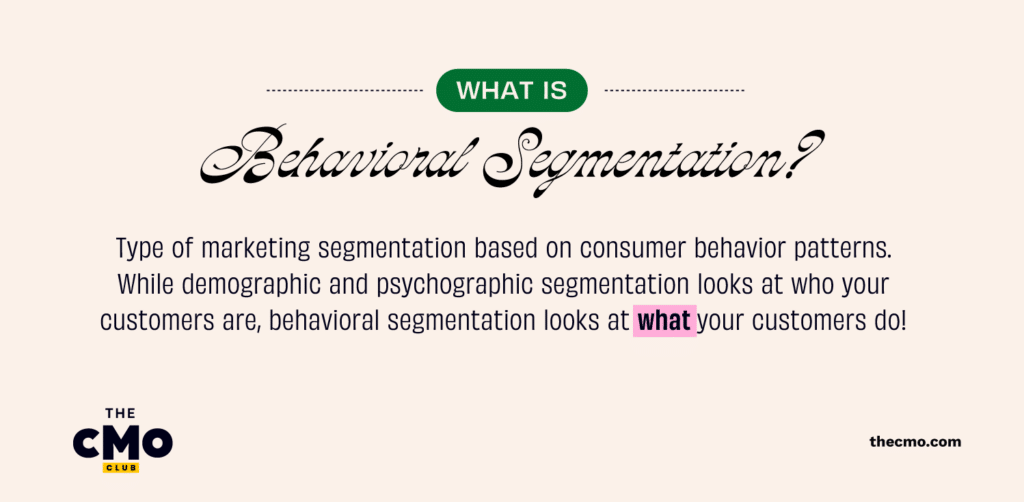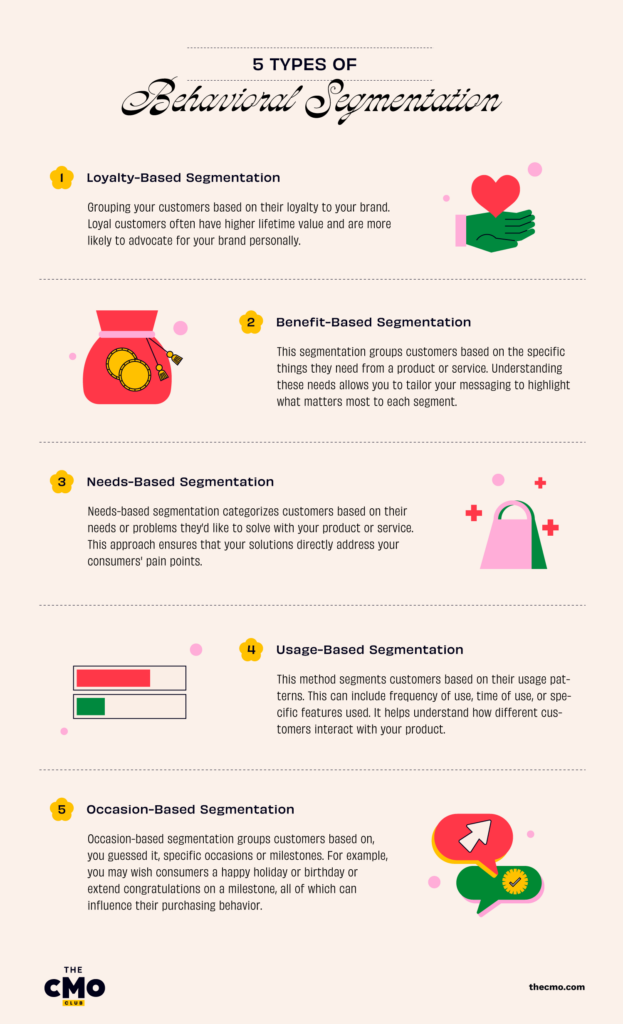Why bother about behavioural segmentation?
Imagine you could predict your customer's next move. How much more efficient would you be?
Imagine you could create an ad that you knew would resonate with your audience? How much more confident would you be in spending those ad dollars?
That's what behavioral segmentation makes possible.
An ABM campaign thrives when it’s precise and personalized. Using behavioral segmentation, you can dig into customer data and craft strategies that hit hard on an individual level. This means stronger relationships and better business outcomes.
Sound like something you’re ready to sign up for? I compiled all you need to know. Let’s dig in!
What is Behavioral Segmentation

First things first, how is this different from other kinds of segmentation?
Behavioral segmentation is a type of marketing segmentation based on consumer behavior patterns. While demographic and psychographic segmentation looks at who your customers are, behavioral segmentation looks at what your customers do!
The Importance of Behavioral Segmentation in ABM
The Forrester US Customer Experience Index found that brand customer experience quality has declined for an unprecedented second year in a row! Behavioral segmentation is an ABM tactic that can boost your overall customer experience, setting you apart from the competition.
You’ll better identify and understand the most engaged users, and you’ll be more cost-effective if you put your money towards already warm leads. Behavioral segmentation will also create a more personalized customer journey for your prospects.
By analyzing your prospect’s habits, you can recommend services, upgrades, and discounts to accelerate the buying process.
You'll increase trust and brand loyalty by meeting your customers where they’re at and treating them like individuals rather than numbers. According to Forrester, devoted customers will pay 50% to 200% more to stay with you in the future.
Who doesn’t want that?
The Five Types of Behavioral Segmentation & How to Use Them in ABM

There are several different ways to use behavioral segmentation in your ABM strategy. Let’s examine each one and consider when it would be most beneficial.
#1. Loyalty-Based Segmentation
Loyalty-based segmentation is grouping your customers based on their loyalty to your brand. Loyal customers often have higher lifetime value and are more likely to advocate for your brand personally.
#2. Benefit-Based Segmentation
This segmentation groups customers based on the specific things they need from a product or service. Understanding these needs allows you to tailor your messaging to highlight what matters most to each segment.
#3. Needs-Based Segmentation
Needs-based segmentation categorizes customers based on their needs or problems they’d like to solve with your product or service. This approach ensures that your solutions directly address your consumers' pain points.
#4. Usage-Based Segmentation
This method segments customers based on their usage patterns. This can include frequency of use, time of use, or specific features used. It helps understand how different customers interact with your product.
#5. Occasion-Based Segmentation
Occasion-based segmentation groups customers based on, you guessed it, specific occasions or milestones. For example, you may wish consumers a happy holiday or birthday or extend congratulations on a milestone, all of which can influence their purchasing behavior.
How to Gather Behavioral Segmentation Data
Behavioral segmentation relies on accurate and comprehensive customer data. Understanding their behavior requires using many different data capture points to get a full picture of who your consumer is. Here’s how to gather it!
- Customer surveys: Design surveys with questions targeting purchasing behavior. Be sure to use different formats like online questionnaires, email surveys, and in-app feedback forms.
- Website analytics: Use platforms like Google Analytics to monitor metrics such as page views, session duration, bounce rates, and conversion paths.
- Purchase history: Record each customer's purchase of products or services, purchase frequency, and average order value. Use CRM systems to track this information!
- Customer service queries and feedback: Track and collect data from support tickets, live chat transcripts, and feedback forms. Find common themes where you can improve.
- Social listening: Use tools like Hootsuite, Brandwatch, or Sprout Social to track keywords, hashtags, and direct mentions to monitor your brand’s credibility and public perception.
- Social media analytics: Take advantage of the analytics features on platforms like Facebook, Twitter, and LinkedIn to monitor engagement in likes, shares, comments, and follower growth.
How to Analyze Behavioral Segmentation Data
Once you have all that customer data, the next step is deciphering all the gold in there. Here are some methods you can use:
- A/B testing: Test different versions of emails, landing pages, or ad copies by splitting your audience into two groups, A and B. Compare which is more effective by looking at metrics like click-through rates, conversion rates, and engagement levels.
- Customer profiling: Boost your CRM platform’s customer profiles by combining demographic, psychographic, and behavioral data to build comprehensive customer profiles.
- Predictive analytics: You can use tools like SAS, and IBM Watson or open-source platforms like R and Python to put predictive models in your data. See how well they can predict customer turnover, purchase likelihood, and response to new marketing campaigns.
- Cohort analysis: Use tools like Mixpanel or Google Analytics to compare how different cohorts (ex., users who signed up in the same month) behave over time.
- Data segmentation: Combine all of your data to better segment your customers based on purchase behavior, engagement level, product usage, and other relevant points. Your CRM and marketing automation tools can help!
5 Mistakes to Avoid When Collecting Behavioral Segmentation Data
Everybody makes mistakes; everybody has those days. But you won’t if you avoid these common mistakes when collecting your behavioral segmentation data.
#1. Collecting Irrelevant Data
When data collection goals are unclear or general, you could end up with irrelevant information that doesn’t contribute to your marketing plans. This is a huge waste of resources and can lead to ineffective campaigns.
Always define your data collection goals clearly to make sure all gathered data is relevant and actionable.
#2. Improper Data Analysis
Misinterpreting your data can lead to incorrect conclusions and, sometimes, embarrassingly, misinformed campaigns. Without proper analysis, the data you collect can be misunderstood, leading to choices that don’t resonate with your target audience.
This is a waste of time and money and can damage customer relationships. Use tried and true marketing analytics tools for accurate data interpretation. You also need to ensure you are using the best marketing segmentation tools.
#3. Coming to Conclusions with Limited Data
Not having enough data is another can of worms that leads to misguided strategies. Relying on a small sample of customers will lead to skewed results that may not accurately represent your broader consumer base.
You’ll miss out on broader insights or make decisions based on outliers.
#4. Discarding Customer Feedback as Being Anecdotal
When you hear feedback, don’t let it go in one ear and out the other. If you ignore customer feedback, you’ll lose opportunities to understand and meet your customer needs better. Customer feedback is a direct line to your customer’s experiences and expectations.
It should absolutely be included in your data analysis!
You’re Off to the Races!
Now that you’ve got the basics of behavioral segmentation, you can use your new secret weapon to take your ABM strategy to the next level. By focusing on what your customers' habits and decisions are, you can create super-personalized and money making campaigns.
You can use various types of behavioral segmentation—loyalty-based, benefit-based, needs-based, usage-based, and occasion-based—to get those insights. Be sure to consistently collect data through customer surveys, website analytics, purchase history, customer service feedback, social listening, and social media analytics.
Then, analyze it all with A/B testing, customer profiling, predictive analytics, cohort analysis, and data segmentation for smart decision-making!
Remember to avoid those common mistakes we discussed. Get it right, and you’ll be golden!
Ready to grow? Subscribe to The CMO newsletter to stay on top of trends and get the latest tips, resources, and guides from our community of seasoned marketing leaders straight to your inbox.


